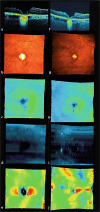Long-term decrease of retinal pigment epithelium defects in large stage iv macular holes with borders mechanically joined during surgery
- PMID: 21829404
- PMCID: PMC3150968
- DOI: 10.1159/000330553
Long-term decrease of retinal pigment epithelium defects in large stage iv macular holes with borders mechanically joined during surgery
Abstract
Purpose: The aim of this paper is to present retinal pigment epithelium (RPE) defects in spectral domain optical coherence tomography (SD-OCT) and their gradual resolution over time.
Materials and methods: Observational case series of 3 eyes of 3 patients who were followed for a period of 3-6 years after undergoing surgery to mechanically close the borders of large stage IV macular holes. Photoreceptor defects and RPE defects were measured during this period with SD-OCT.
Results: In all cases, a reduction in the size of the areas of photoreceptor and RPE defects was noted, which correlated with late improvement in visual acuity (VA).
Conclusions: In eyes with no underlying retinal pigment epithelial or choroidal disease, restoration of RPE is possible in vivo for up to several years after surgery for macular hole closure. An improvement in VA is possible, even lasting many years after successful macular hole surgery, which corresponds to a decrease in both RPE defects and the size of the defects in the junction between the inner and outer segments of photoreceptors.
Keywords: Macular hole; Photoreceptor defects; Retinal pigment epithelium defects; Spectral domain optical coherence tomography.
Figures


Similar articles
-
Continuous changes in macular morphology after macular hole closure visualized with spectral optical coherence tomography.Graefes Arch Clin Exp Ophthalmol. 2010 Sep;248(9):1249-55. doi: 10.1007/s00417-010-1370-5. Epub 2010 Apr 9. Graefes Arch Clin Exp Ophthalmol. 2010. PMID: 20379735
-
[Multimodal Approaches for the Analysis of Retinal Functional Disorders―Focusing on Retinal Detachment].Nippon Ganka Gakkai Zasshi. 2017 Mar;121(3):185-231. Nippon Ganka Gakkai Zasshi. 2017. PMID: 30088405 Japanese.
-
CLASSIFICATION AND QUANTITATIVE ANALYSIS OF GEOGRAPHIC ATROPHY JUNCTIONAL ZONE USING SPECTRAL DOMAIN OPTICAL COHERENCE TOMOGRAPHY.Retina. 2018 Aug;38(8):1456-1463. doi: 10.1097/IAE.0000000000001824. Retina. 2018. PMID: 28834947
-
Photoreceptor layer features in eyes with closed macular holes: optical coherence tomography findings and correlation with visual outcomes.Am J Ophthalmol. 2005 Feb;139(2):280-9. doi: 10.1016/j.ajo.2004.09.029. Am J Ophthalmol. 2005. PMID: 15733989
-
[Pathophysiology of macular diseases--morphology and function].Nippon Ganka Gakkai Zasshi. 2011 Mar;115(3):238-74; discussion 275. Nippon Ganka Gakkai Zasshi. 2011. PMID: 21476310 Review. Japanese.
Cited by
-
Management of Stage IV Macular Holes: When Standard Surgery Fails.Case Rep Ophthalmol. 2012 May;3(2):240-50. doi: 10.1159/000342007. Epub 2012 Aug 8. Case Rep Ophthalmol. 2012. PMID: 23071465 Free PMC article.
-
Relaxing Retinotomy in Recurrent and Refractory Full-Thickness Macular Holes: The State of the Art.Life (Basel). 2023 Aug 31;13(9):1844. doi: 10.3390/life13091844. Life (Basel). 2023. PMID: 37763248 Free PMC article. Review.
-
A Review of Surgical Outcomes and Advances for Macular Holes.J Ophthalmol. 2018 Apr 18;2018:7389412. doi: 10.1155/2018/7389412. eCollection 2018. J Ophthalmol. 2018. PMID: 29850211 Free PMC article. Review.
References
-
- Kelly NE, Wendel RT. Vitreous surgery for idiopathic macular holes: results of a pilot study. Arch Ophthalmol. 1991;109:654–659. - PubMed
-
- Ando F, Sasano K, Ohba N, et al. Anatomic and visual outcomes after indocyanine green-assisted peeling of the retinal internal limiting membrane in idiopathic macular hole surgery. Am J Ophthalmol. 2004;137:609–614. - PubMed
-
- Beutel J, Dahmen G, Ziegler A, Hoerauf H. Internal limiting membrane peeling with indocyanine green or trypan blue in macular hole surgery: a randomized trial. Arch Ophthalmol. 2007;125:326–332. - PubMed
-
- Alpatov S, Shchuko A, Malyshev V. A new method of treating macular holes. Eur J Ophthalmol. 2007;17:246–252. - PubMed
-
- Michalewska Z, Michalewski J, Adelman RA, Nawrocki J. Inverted internal limiting membrane (ILM) flap technique for large macular hole. Ophthalmology. 2010;117:2018–2025. - PubMed
Publication types
LinkOut - more resources
Full Text Sources

